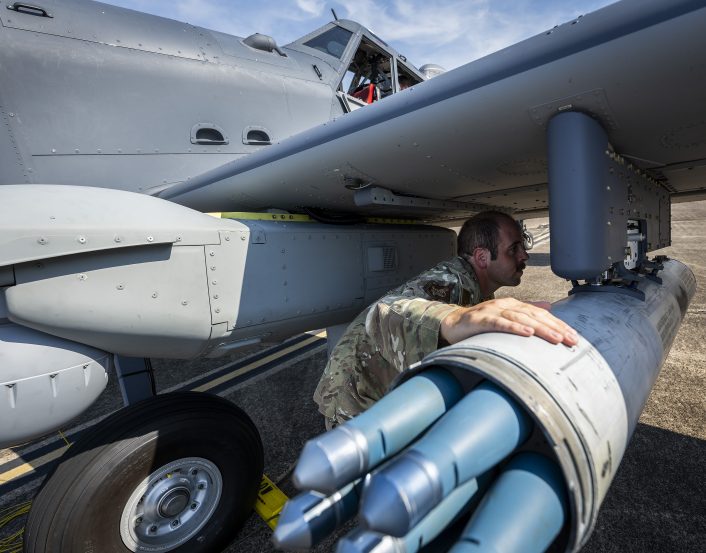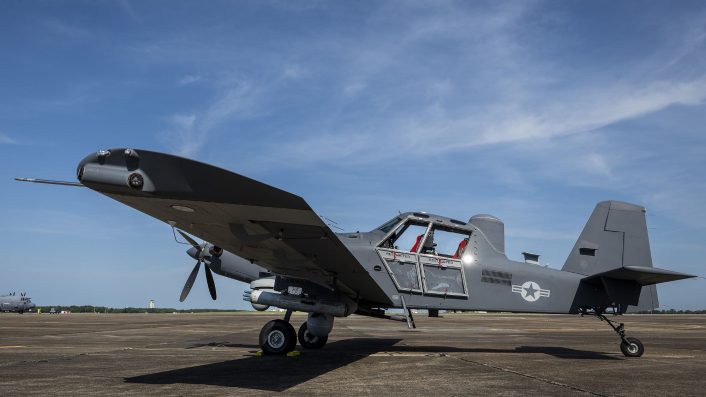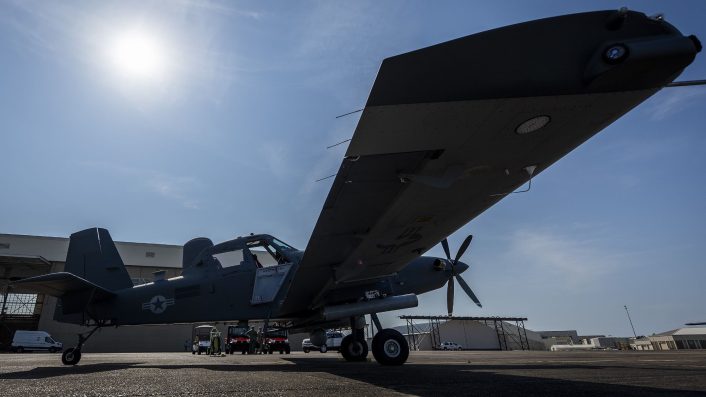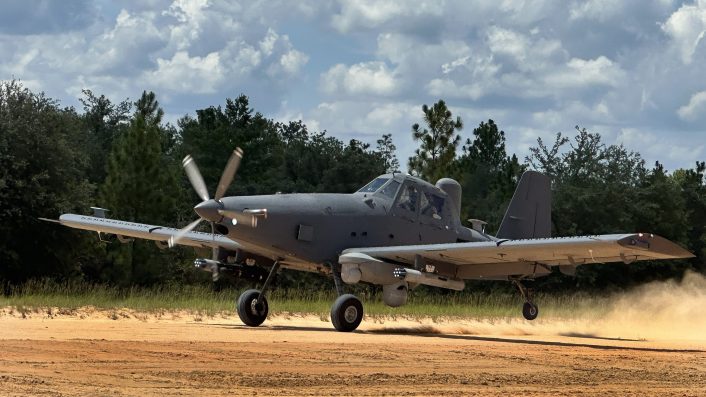As the Skyraider II is the USAF’s first tailwheel aircraft in over 50 years, test evaluators had to devise a new methodology to verify its performance.
The AFSOC’s (Air Force Special Operations Command) OA-1K Skyraider II aircraft is currently undergoing developmental testing at Eglin AFB, Florida, with the 96th Test Wing (96th TW) and the USSOC (U.S. Special Operations Command), the Air Force Materiel Command announced on Jul. 28, 2025. The aircraft is being put through the paces to ensure it can meet operational requirements for its proposed special operation mission.
The press release listed “human factor, handling quality and austere landing missions” as the the OA-1K’s current test objectives, with future tests involving “sensor quality and weapons release.” The ongoing campaign will also “evaluate the Skyraider II’s military airworthiness and verify the manufacturer’s performance data accuracy,” the statement added.
Images released on the DVIDS network on Jul. 29, 2025 but taken on Jun. 25 and Jul. 10, show the Skyraider II during routine operations, as well as landing on a dirt path as a part of the ongoing campaign.
This airframe could possibly be the first missionized variant of the L3Harris/Air Tractor OA-1K Skyraider II delivered to the AFSOC on Apr. 3, 2025, at Hurlburt Field, Florida. However, unlike the first OA-1K, this one does not bear the L3Harris logo on the left side of the fuselage, the experimental markings and the orange air data probe.
🛠️The 96th Test Wing continues developmental testing of the OA-1K Skyraider II, @AFSpecOpsCmd‘s newest aircraft, to ensure it can meet operational requirements. #OneAFMC @TeamEglin
Learn more: https://t.co/uuyvsUl1Zg pic.twitter.com/flbVSJpi8W
— U.S. Air Force Materiel Command ✈️ (@HQ_AFMC) July 29, 2025
Testing campaign
The Skyraider II is the first aircraft in U.S. Air Force’s inventory to feature a tailwheel in over five decades. This required test evaluators to devise “a new methodology to verify its performance,” said the press release.
Test pilots of various backgrounds, who volunteered to test the Skyraider II, underwent extra training with the Skyraider II’s civilian variant, the AT-802U, to “learn to fly the tailwheel aircraft effectively,” explained the service. This could be also a reference to the AT-802Us that were delivered to start the training for the pilots that would fly the new aircraft.

Maj. Stephen Wakefield from the 96th TW said the testing campaign was preceded by preparations to ensure regulatory compliance and the proper operations support for the Skyraider II. Among these preparations was the extra training for tailwheel aircraft.
“Flying the OA-1K has been a rewarding experience and certainly something that has required me to bring my skills to work every day,” said Maj. Jacob Marsh, 96th TW. “The fun of flying it is just a perk of the job.”
In the photos, the OA-1K can be seen with different configurations of weapons, based on two LAU-131 A/A 7-round rocket pods on the outer pylons, with the right inner pylon carrying a Moog Dual Rail Launcher (DRL) and the left one carrying a Multi-Modal Sensor Pod (MMSP) with WESCAM MX-15 and MX-20 EO-IR turrets. In some photos the aircraft is only carrying inert rockets in one pods, while in others – like the photo from the dirt strip – the Skyraider II fully armed with its complete intended payload of 14 APKWS II rockets and two AGM-114 Hellfire missiles.
The tandem-seat Skyraider is flying with both the pilot and the Combat Systems Operator (CSO) during the tests. The release described the OA-1K Skyraider II as “a new cost-effective crewed aircraft” that can “support geographically isolated special operations personnel in austere locations,” with “close air support, precision strike or armed intelligence, surveillance and reconnaissance” capabilities.

L3Harris/Air Tractor OA-1K Skyraider II
The OA-1K Skyraider II is a derivative of the AT-802U, and was developed in response to the AFSOC’s Armed Overwatch program in 2022. AFSOC officials revealed the ‘Skyraider II’ designation for the aircraft during the Special Air Warfare Symposium on Feb. 27, 2025. The name revives the legacy of the rugged and versatile A-1 Skyraider, which served from 1946 through the early 1980s.
Air Tractor and L3Harris beat the Beechcraft AT-6 Wolverine, Embraer A-29 Super Tucano, and PZL M28B 1R Bryza for the $3 billion AFSOC deal. The Skyraider II aircraft are built in Olney, Texas, by Air Tractor and outfitted by L3Harris for the armed overwatch mission in Tulsa, Oklahoma.
AFSOC previously received two AT-802U trainer aircraft at Hurlburt Field on Jun. 28, 2024, to train crews for the missionized Armed Overwatch (OA-1K) variant. This was followed by the 137th Special Operations Wing of the Oklahoma ANG receiving its first AT-802U at Will Rogers International Airport in Oklahoma City on Jul. 29.
Additional aircraft from the order of 75 units will head from the production line to the Will Rogers Air National Guard Base, Oklahoma “in the coming months.” The base hosts the Formal Training Unit (FTU) for the OA-1K.

Systems and configuration
The Skyraider II has two EO/IR (Electro-Optical/Infrared) turrets on the Multi-Modal Sensor Pod (MMSP) of the left wing’s inner hardpoint. Both sensors – a WESCAM MX-20 in the back and an MX-15 in the front – can be operated simultaneously by the front-seated pilot and the rear-seated CSO.
The OA-1K’s standard weapon loadout includes two seven-round LAU-131 A/A rocket pods, loaded with APKWS II laser guided rockets, and two AGM-114 Hellfire missiles on a Moog Dual Rail Launcher. The LAU-131s are installed on the outer hardpoints, while the Moog DRL is on the right wing’s inner hardpoint.
For survivability, the OA-1K has AN/AAR-47 Missile Approach Warning Sensors (MAWS) on the wingtips, as well as AN/ALE-47 Airborne Countermeasures Dispenser System on the underside of the wings.
The large ‘bump’ on the back is a Ku-band SATCOM (Satellite Communications) system for BLOS (Beyond Line-of-Sight) communications. The aircraft also has five other conventional radio communications suites for both LOS and BLOS communications, operating in various bands and frequencies ranges.
The aircraft can also connect with ground teams with data links, who can remotely control the EO sensors. For classic armed overwatch, ISR (Intelligence, Surveillance and Reconnaissance) and strike missions, either of the crew can locate a target on the ground/map and put it in a target waypoint list, which sends it over to a Garmin navigation system, and then activate the autopilot to set up an orbit around the spot.










